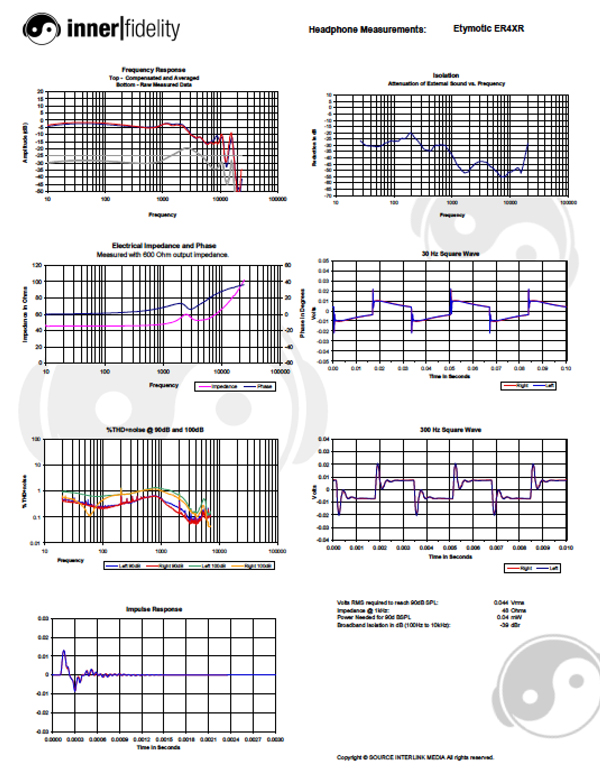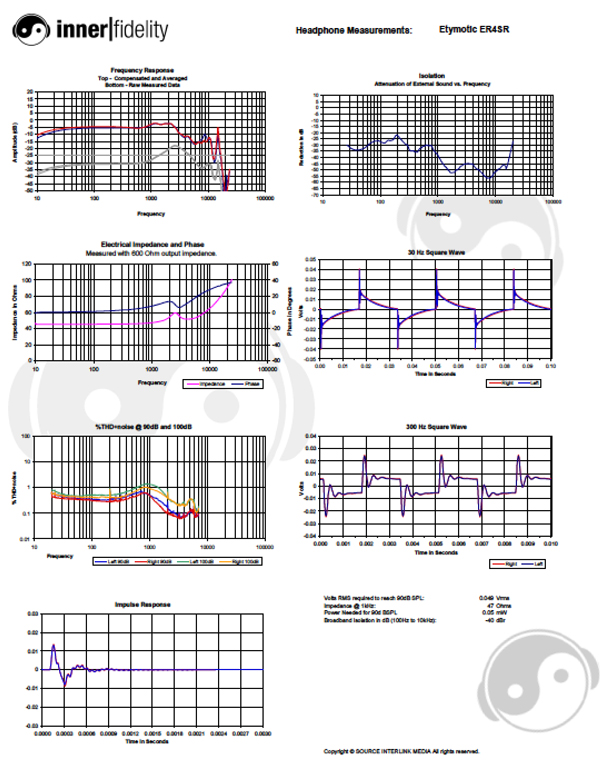| Columns Retired Columns & Blogs |
25 Years of Making a Good Thing Better: The Etymotic ER4sr and ER4XR Measurements
ER4XR Measurements


Click on graphs image to download .pdf for closer inspection.
Click on graphs image to download .pdf for closer inspection.
Raw frequency response plots of these earphones show they are essentially identical above about 800Hz, where they follow the neutral target well. Below 800Hz, the XR is very flat until it begins to gently roll-off around 80Hz; the XR starts a gentle rise at around 500Hz to a broad peak centered at 45Hz about 3dB higher. While I like the extra bass of the XR, the bump is too broad extending into the mids. If they had bumped up the bass more, it would excessively thicken the low mids. So while I'd like more low bass, I think Etymotic was judicious in their tuning to keep the mids in shape.
It's worth noting the distinct peaks in the upper treble. These are ear canal resonances in their natural positions and will generally not be consciously heard due to psychoacoustic masking.
The XR shows very nice shape in the 30Hz square wave. The SR gentle swayback indicates it's low frequency roll-off. For me, this just reinforces my preference for the XR. (The difference in the initial spike should be ignored as it's a result of setting the test levels with a low frequency tone. Note the 300Hz square wave initial peaks are much more similar.)
300Hz square wave are quite similar though the SR appears to be slightly less damped in the ringing after the initial peak. I think this actually might be a result of the gentle upward tilt of the remaining waveform masking the last ring, while the gentle downward tilt of the SR response acts to reveal more of the ring. Anyhow, to my eyes the peak at the initial transient seems a tad high, but the response otherwise is near ideal. This headphone should, and does, have excellent treble resolution.
The high frequency wiggles in the impulse response are due to ear canal resonance at 15kHz, and can essentially be ignored. Ideally damped would have the slight rise above zero after the undershoot go away, but that's picking nits, this is a very good, clean impulse response.
100dBspl THD+noise plots show the XR has a broader distortion peak around 1kHz and higher distortion broadly in the bass. Note the 90dBspl curves are very close to identical. I think I did perceive the XR as ever so slightly harder sounding at high levels and loud passages, but in normal listening I can't say I heard any differences clearly.
Impedance plot shows a nominally 45 Ohm headphone. This relatively low impedance coupled with the rapidly rising impedance after 5kHz will cause these headphones to brighten up with player devices that have more than 5 Ohms output impedance.
Isolation plots shows very good isolation across the spectrum. A broadband measure of isolation at -39dB is astonishingly good.
With 44mVrms needed to achieve 90dBspl at the ear, these headphone will play to solid listening levels with portable devices.
- Log in or register to post comments





































